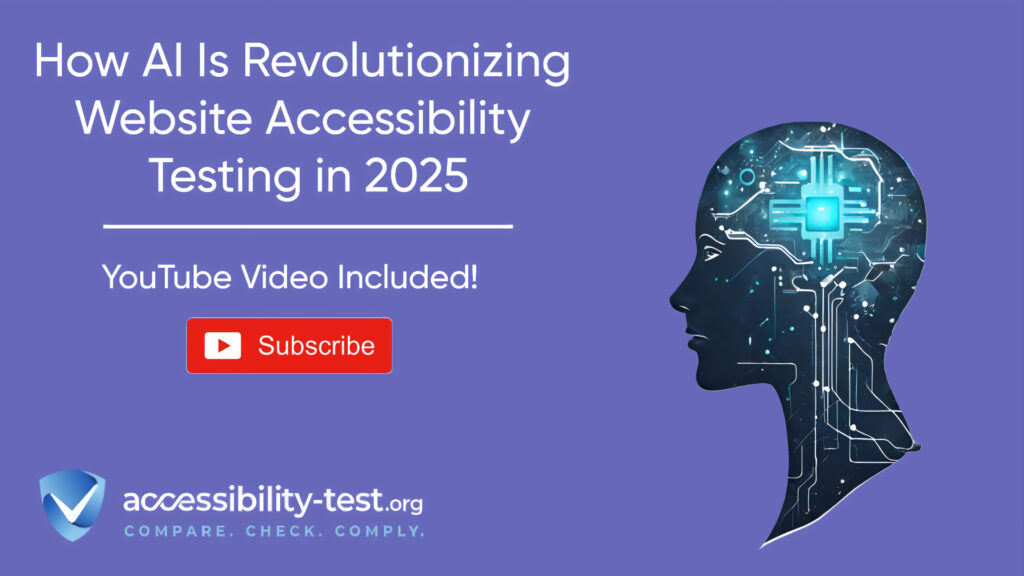
The landscape of digital accessibility has undergone a remarkable transformation with the integration of artificial intelligence technologies. As we progress through 2025, AI has emerged as a game-changing force in identifying, remediating, and preventing accessibility barriers across digital platforms. This revolution is not merely about compliance with standards like WCAG 2.2 or meeting legal requirements; it represents a fundamental shift toward more inclusive digital experiences that benefit all users regardless of their abilities. The integration of AI into accessibility testing has accelerated the pace at which organizations can achieve compliance while significantly reducing the resources required, making digital inclusivity more attainable than ever before.
The Evolution of Accessibility Testing
Traditional accessibility testing has historically relied on a combination of automated tools with significant limitations and resource-intensive manual audits. Before the AI revolution, automated tools could only identify approximately 30-40% of accessibility issues, leaving the majority to be discovered through labor-intensive manual testing processes. These conventional approaches presented several critical challenges: they were time-consuming, expensive, inconsistent, and often resulted in accessibility being treated as an afterthought rather than integrated into the development lifecycle.
The emergence of AI-powered solutions has dramatically transformed this landscape. According to recent data from Deque Systems, their AI-enhanced testing capabilities now allow automated detection of up to 57% of accessibility issues by volume, with further advances projected to increase this coverage to nearly 70% by the end of 2025. This represents a paradigm shift in how organizations approach accessibility testing, moving from reactive remediation to proactive prevention.
The evolution has been particularly notable in addressing the complexities of dynamic content, which traditional testing tools struggled to evaluate accurately. Modern AI systems can now analyze user interfaces as they change in response to interactions, providing a much more comprehensive assessment of accessibility across various states of web applications. This capability is essential for contemporary web experiences that rely heavily on JavaScript frameworks and dynamic content rendering.
The Role of AI in Automated Testing Tools
Artificial intelligence has fundamentally transformed automated accessibility testing through sophisticated algorithms that mimic human perception and judgment. Unlike traditional rule-based systems, AI-powered tools employ machine learning models trained on vast datasets of accessibility patterns to identify issues with unprecedented accuracy and nuance.
One of the most significant advances is in real-time issue detection. Tools like LambdaTest now scan websites continuously during development, identifying WCAG compliance issues such as color contrast errors and missing alt text within minutes. This immediate feedback allows developers to address accessibility barriers as they code, rather than discovering them later in the development cycle when remediation is more costly and disruptive.
Integration with development workflows has become seamless through AI-powered plugins and extensions for popular development environments. For example, Deque’s advanced ruleset leverages machine learning to analyze code patterns during development, providing contextual guidance on potential accessibility issues before code is even committed. This integration ensures that accessibility becomes part of the development process rather than a separate testing phase.
Continuous monitoring capabilities represent another crucial advancement. As websites evolve through content updates and feature additions, maintaining accessibility compliance becomes challenging. AI systems now provide ongoing assessment of digital properties, automatically alerting teams when new content or features introduce accessibility barriers. Level Access’s AI monitoring system, for instance, not only identifies issues but also prioritizes them based on impact severity and user patterns, helping teams allocate remediation resources efficiently.
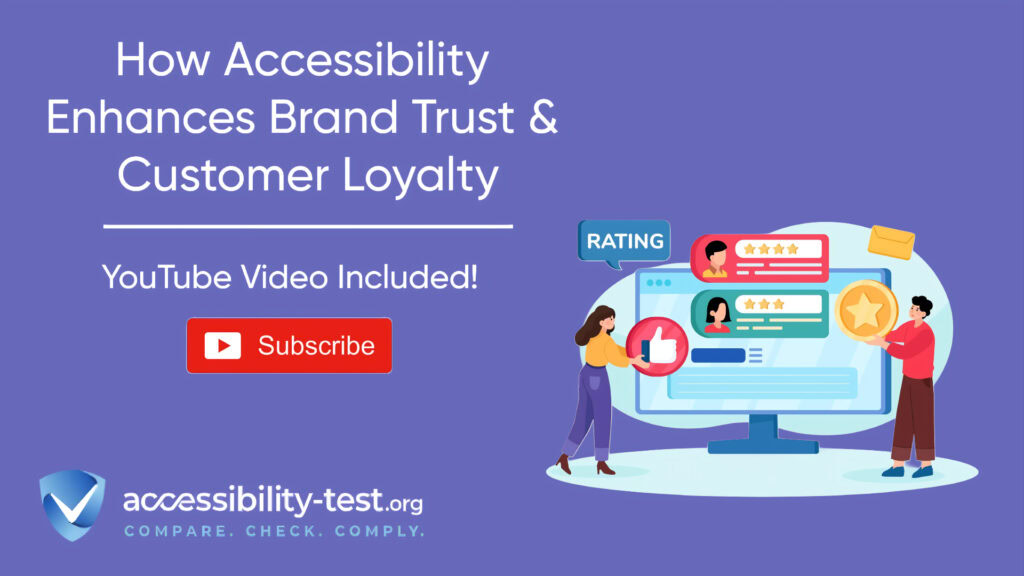
Identifying Patterns in Common Violations
AI’s analytical capabilities shine particularly bright in identifying recurring accessibility patterns across websites and applications. By processing data from thousands of accessibility audits, these systems can recognize common violation patterns that might elude human testers working on individual pages or features.
For instance, AI tools like Deque’s axe have become adept at identifying nuanced issues in ARIA implementation. The analysis of large datasets has revealed that developers frequently misuse ARIA attributes in predictable ways—such as applying improper roles to elements or failing to update ARIA states during user interactions. By recognizing these patterns, AI can provide targeted guidance that addresses the root causes of accessibility failures rather than just flagging individual instances.
Color contrast violations represent another area where pattern recognition proves valuable. AI systems can analyze design systems holistically, identifying when brand colors consistently create contrast issues across multiple elements or contexts. This comprehensive view enables organizations to address systemic design problems rather than making piecemeal fixes, resulting in more consistent accessibility throughout the user experience.
Another significant pattern involves the implementation of form controls and validation mechanisms. AI tools can now recognize when forms lack proper labeling patterns or when validation messages are implemented inconsistently, creating barriers for screen reader users. By identifying these patterns across entire websites, remediation efforts can be focused on establishing proper control patterns that developers can replicate consistently.
The power of this pattern recognition extends beyond simple issue detection to offering predictive insights. Advanced AI systems can now anticipate where accessibility issues are likely to occur based on observed development practices, allowing teams to implement preventative measures before problems materialize.
Reducing False Positives with Machine Learning
One of the most significant challenges in automated accessibility testing has been the high rate of false positives—instances where tools incorrectly flag elements as violations. These false alarms have historically undermined trust in automated testing and consumed valuable developer time in verifying results. Machine learning has made remarkable progress in addressing this problem.
Deque’s advanced ruleset, powered by AI and machine vision, has dramatically reduced false positives by analyzing screenshots alongside code. This multimodal approach provides context that pure code analysis cannot achieve. For example, when evaluating whether an image without alt text is decorative or informative, the system can analyze the visual content, surrounding elements, and user interaction patterns to make a more accurate determination.
Context-aware analysis represents another breakthrough in reducing false positives. Traditional tools might flag a low-contrast text element without considering that it’s part of a disabled button state that doesn’t require the same contrast requirements. AI systems can now understand these contextual nuances, dramatically improving testing accuracy.
The combination of natural language processing and visual analysis has proven particularly effective for evaluating link text quality. While traditional tools might flag a “read more” link as insufficient, AI can analyze the surrounding content to determine if the context provides sufficient meaning, reducing unnecessary flags while still identifying genuinely problematic implementations.
These improvements in accuracy deliver tangible benefits beyond just reducing noise. Developers who trust their testing tools are more likely to address the issues those tools identify, leading to more comprehensive remediation. Additionally, the reduction in manual verification time allows teams to focus on solving genuine accessibility problems rather than sorting through false alarms.
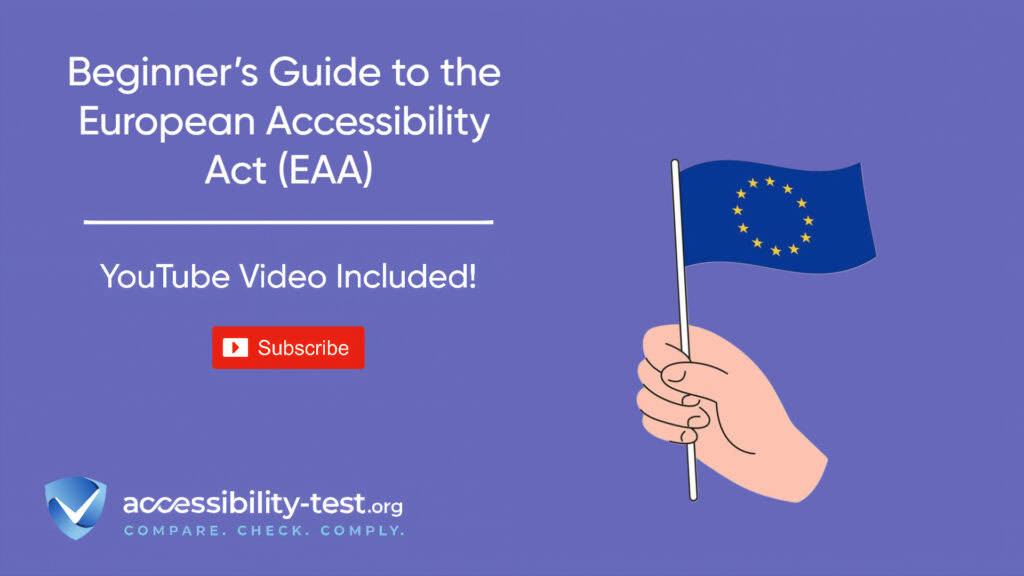
Advanced AI Capabilities in 2025
As we progress through 2025, AI capabilities in accessibility testing have reached new heights of sophistication. Today’s advanced systems go far beyond simple issue detection to offer remediation guidance, personalized adaptations, and proactive design assistance.
Smart interface adjustments represent one of the most transformative capabilities. Level Access’s AI system can now automatically modify interfaces in real-time based on individual user needs. These adaptations include adjusting font sizes, enhancing contrast ratios, simplifying layouts for cognitive accessibility, and optimizing navigation patterns based on user interaction data. This capability ensures that websites become more usable for people with disabilities without requiring explicit configuration by either users or developers.
Cognitive accessibility support has emerged as a frontier where AI is making exceptional progress. Tools like Siteimprove now employ natural language processing to identify and simplify complex content, making it more accessible to users with cognitive disabilities. These systems can automatically generate plain language alternatives for complex terminology, reorganize information into more digestible chunks, and provide supplementary explanations for concepts that might be challenging for some users to understand.
Code generation and remediation assistance represent another breakthrough capability. Axe Assistant and similar AI agents can now generate accessible code snippets and suggest specific fixes for identified issues. These suggestions are contextually aware, taking into account the surrounding code, design patterns, and best practices. For developers who may lack deep accessibility expertise, this guidance dramatically accelerates the remediation process and builds knowledge over time.
Perhaps most impressively, AI systems in 2025 can now assist with Intelligent Guided Tests (IGTs) that traditionally required significant manual intervention. Deque’s AI-assisted testing can now automatically answer many of the subjective questions that previously required human judgment, such as determining if animation is distracting or if error messages are sufficiently descriptive. This capability bridges the gap between fully automated and manual testing, extending coverage to approximately 80% of potential accessibility issues.
Leading AI Accessibility Tools in 2025
The accessibility testing landscape in 2025 features several sophisticated AI-powered solutions, each with distinct capabilities and advantages. Understanding these tools helps organizations select the right solution for their specific needs and accessibility maturity level.
LambdaTest has emerged as a leader in continuous monitoring and development integration. Its AI engine performs real-time scans of websites and applications, identifying accessibility issues within minutes. The platform excels in speed and efficiency, making it particularly valuable for organizations with frequent deployment cycles. Its integration capabilities with development environments allow teams to catch issues during coding, significantly reducing remediation costs compared to post-deployment discovery.
Deque’s Axe ecosystem represents the gold standard for accuracy and comprehensive coverage. Their advanced ruleset, powered by sophisticated AI, machine vision, and screenshot analysis, has achieved unprecedented accuracy while maintaining their zero false-positive commitment. The 2025 version of Axe DevTools Extension incorporates these advanced capabilities, increasing automated test coverage by up to 10% compared to traditional approaches. Additionally, Axe Assistant provides AI-guided remediation support through Slack and Teams, making accessibility expertise available throughout the development process.
Level Access offers perhaps the most advanced real-time adaptation capabilities in the current market. Their AI system not only identifies accessibility issues but can also dynamically adjust interfaces based on detected user needs. These adjustments include modifications to layouts, fonts, and contrast to ensure better usability for users with various disabilities. This capability is particularly valuable for organizations seeking to provide personalized experiences beyond basic compliance.
Siteimprove has positioned itself as a leader in cognitive accessibility support. Their AI tools help simplify complex language, provide live captioning, and improve content clarity for users with cognitive challenges. The platform takes a holistic approach that extends beyond technical compliance to address usability concerns that impact all users, particularly those with cognitive disabilities. This focus on cognitive accessibility represents an important frontier as organizations move beyond addressing just visual and motor accessibility requirements.
AccessiBe and UserWay take different approaches, focusing on overlay solutions that implement accessibility adjustments through JavaScript. While these tools offer rapid implementation and can address certain issues quickly, they have limitations in addressing underlying code problems. They remain valuable for organizations beginning their accessibility journey but typically need to be complemented with more comprehensive testing and remediation processes for complete compliance.
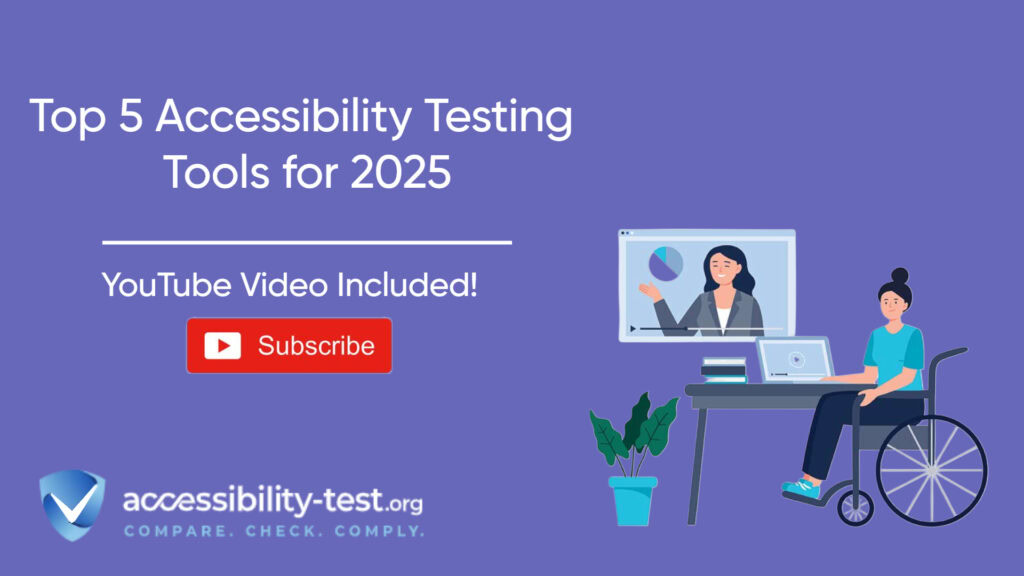
Compliance and Regulations in 2025
The regulatory environment for digital accessibility has evolved significantly by 2025, creating both challenges and opportunities for organizations worldwide. Understanding this landscape is essential for prioritizing accessibility efforts and managing compliance risks effectively.
The European Accessibility Act (EAA) represents one of the most significant regulatory developments, with a June 2025 deadline for compliance. This directive requires businesses selling products and services in European markets to ensure their digital offerings comply with EN 301 549 standards, which are closely aligned with WCAG 2.1 AA. The scope extends beyond websites to mobile applications, e-commerce platforms, and digital interfaces embedded in physical products. Non-compliance carries potentially significant penalties and market access restrictions, making this deadline particularly important for global organizations.
In the United States, the legal framework continues to evolve through litigation rather than new regulation. The trend of ADA Title III lawsuits has continued to increase annually, with websites and mobile applications remaining the primary targets. Courts have increasingly recognized WCAG conformance as a standard for determining ADA compliance, despite the absence of explicit technical standards in the legislation itself. This litigation-driven enforcement creates particular incentives for proactive accessibility implementation.
AI-powered testing tools have become invaluable in navigating this complex regulatory landscape. These systems can now map identified issues directly to specific WCAG success criteria and regulatory requirements, helping organizations prioritize remediation efforts based on compliance risk. Additionally, continuous monitoring capabilities ensure that websites remain compliant as content and features evolve, reducing the risk of inadvertently introducing new barriers after achieving initial compliance.
Risk management has become a central focus for organizations addressing accessibility in 2025. AI tools now offer risk scoring mechanisms that evaluate the severity of identified issues based on both technical impact and legal precedent. This capability helps organizations prioritize remediation efforts to address the most significant compliance risks first, making effective use of limited resources while steadily improving overall accessibility.
The regulatory pressure, combined with improved testing tools, has shifted organizational approaches from reactive compliance to proactive implementation. Forward-thinking companies now integrate accessibility requirements into design systems and development processes, preventing issues before they occur rather than remediating them after deployment.
Visit Our Tools Comparison Page!
Successfully implementing AI-powered accessibility testing requires thoughtful planning and strategic execution. Organizations that have achieved the greatest success follow several key implementation practices tailored to their specific needs and maturity level.
Establishing clear baseline metrics represents a crucial first step in any implementation. Before deploying AI testing tools, organizations should conduct a comprehensive assessment of their current accessibility status. This baseline provides a reference point for measuring improvement and helps inform prioritization decisions. AI-powered scanning tools can accelerate this initial assessment by quickly identifying patterns of issues across large digital properties.
Integration with existing development workflows is essential for sustainable implementation. Rather than treating accessibility as a separate process, leading organizations incorporate AI testing tools directly into their development environments and CI/CD pipelines. This integration ensures that accessibility checks become a standard part of the development process, with issues identified and addressed alongside other code quality concerns. For example, Deque’s Axe DevTools Extensions can be integrated directly into IDE environments, providing real-time feedback during coding.
A phased implementation approach has proven most effective for most organizations. This typically begins with focusing on new development to prevent the introduction of new barriers while gradually addressing existing content. AI tools can help prioritize remediation of legacy content by identifying high-impact issues that affect the most frequently used journeys or pages with the highest visibility.
Capacity building must accompany tool implementation for sustainable success. While AI tools significantly reduce the knowledge barrier to accessibility implementation, they function best when teams understand fundamental accessibility principles. Organizations should invest in training developers, designers, and content creators on accessibility basics, enabling them to make more effective use of AI guidance and recommendations.
Monitoring and continuous improvement complete the implementation cycle. AI-powered continuous monitoring ensures that accessibility levels are maintained as websites evolve. Regular reporting on key metrics helps track progress toward compliance goals and identify areas requiring additional attention. This ongoing assessment creates accountability and demonstrates commitment to accessibility as a business priority.
Run a FREE scan to check compliance and get recommendations to reduce risks of lawsuits
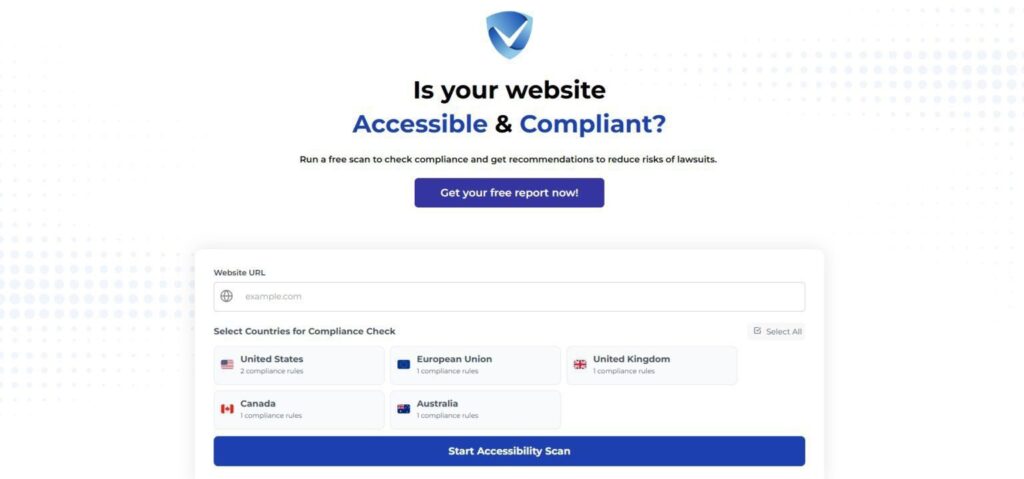
Don’t wait to take action—audit your site’s SEO-accessibility health today with our free tool! Identify gaps, implement fixes, and ensure compliance with the latest guidelines to dominate SERPs while creating an inclusive experience for all users. Take the first step toward accessibility success now!



